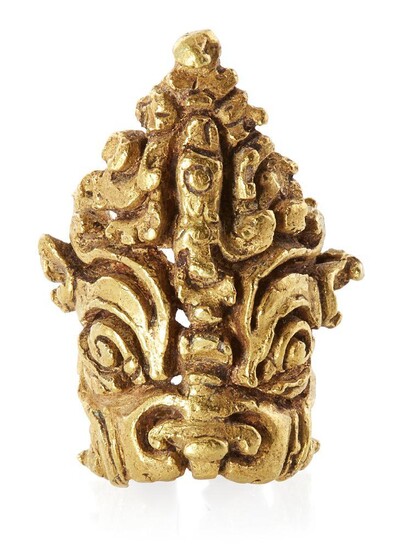A Gupta gold hair ornament of Kirtimukha, India, 5th-8th century, in the form of a male mask with deep set eyes and exaggerated brows wearing a pointed crown heavily cast and carved in deep relief, weight 9.4 grams The exact function of these...
A Gupta gold hair ornament of Kirtimukha, India, 5th-8th century, in the form of a male mask with deep set eyes and exaggerated brows wearing a pointed crown heavily cast and carved in deep relief, weight 9.4 grams The exact function of these objects is as yet undetermined. They are found across the Hindu/Buddhist koine and have been variously described as hair ornaments, ear ornaments and bird rings. Kirtimukha (glorious face) was so named by Lord Shiva because only his scary face was left after the all-devouring monster, Jalandhara, was ordered by Shiva to eat his own body starting with his tail. See M.E. Aitken, When Gold Blossoms: Indian Jewellery from the Susan L. Beningson Collection, p. 53, no. 10 and also U. Balakrishnan and M.S. Kumar The Dance of the Peacock; Jewellery Traditions of India, Mumbai, 1999, p. 26, fig. 19 and p. 74, fig. 97a-b. For an example sold at auction see Sotheby's, The Indian Sale, 8 May 1997, Lot 147
[ translate ]View it on
Estimate
Reserve
Time, Location
Auction House
A Gupta gold hair ornament of Kirtimukha, India, 5th-8th century, in the form of a male mask with deep set eyes and exaggerated brows wearing a pointed crown heavily cast and carved in deep relief, weight 9.4 grams The exact function of these objects is as yet undetermined. They are found across the Hindu/Buddhist koine and have been variously described as hair ornaments, ear ornaments and bird rings. Kirtimukha (glorious face) was so named by Lord Shiva because only his scary face was left after the all-devouring monster, Jalandhara, was ordered by Shiva to eat his own body starting with his tail. See M.E. Aitken, When Gold Blossoms: Indian Jewellery from the Susan L. Beningson Collection, p. 53, no. 10 and also U. Balakrishnan and M.S. Kumar The Dance of the Peacock; Jewellery Traditions of India, Mumbai, 1999, p. 26, fig. 19 and p. 74, fig. 97a-b. For an example sold at auction see Sotheby's, The Indian Sale, 8 May 1997, Lot 147
[ translate ]


